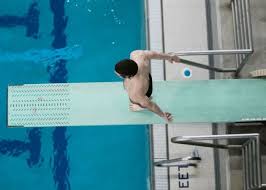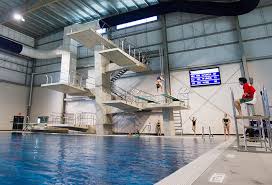
About Diving
Diving is one of the most loved and watched sports of aquatics. Different acrobatics skills are performed by the divers during their dive. The divers need to extremely fit, athletic and flexible to accomplish this event.
The diving board placed at three metres, popularly known as the Springboard, and the one placed, at a height of 10 metres popularly known as the Platform. All the events are restricted to these two heights.
Men and women participate in diving in their events. Apart from individual diving, this sport also includes synchronized diving for a three-metre Springboard and 10 m Platform.
Divers are awarded points by the judges after each dive. The diver accumulating the maximum number of points is declared as the winner. The same goes with synchronized diving, the team, awarded the maximum points wins the event.
Diving being an aquatic sport, it is governed by Fédération Internationale de natation (FINA). Diving was introduced as a sport in 1904 in Olympics. The Springboard event was introduced in 1908. Women’s event was introduced in 1912 Olympics with Springboard event introduced, in 1920 for women.
Diving Olympic 2020 logo : 
History
The thrill of diving into the water headfirst from a higher place is age-old. The first known competition was organized, in Britain leading to the formulation of the Amateur Diving Association of England in 1901.
This sport came under the purview of Fédération Internationale de natation (FINA) in 1973, and FINA organizes diving competitions all over the world.
Objective
The objective of this sport is to produce a perfect diving routine through all their jumps and acquire maximum points from the judges.
The diver acquiring maximum points after completing all the five jumps for women and six jumps for men is declared as the winner.
Events In Diving
Elements Of Diving
The five diving elements that judges take into account while pointing a dive are:
Starting Position: The posture of the diver should be good. The diver should be standing straight and not bent moreover, the head and body of the diver should be aligned with two feet together except for the handstand dives. For handstand dives, the diver should display a balance while balancing on their hands. The feet should be together and pointing to the top.
The Approach: The approach of the diver for starting the dive from the starting position is the most difficult part of the diver. There are butterflies in the stomach, and the mind is full of the acrobatic manoeuvre the diver needs to perform. The approach should be smooth and pleasing.
Takeoff: The diver achieves good height with takeoff; it should be smooth and balanced.
Flight: The initial jump by diver allows them to attain more height to perform their acrobatics perfectly. The more height attained by the diver, the more time they get to perform. The diver should only perform the dive according to the dive list provided to judges. The body of the diver should be tight and precise.
Entry In Water: The diver’s body should be straight with arms and legs straight together, and toes pointed. The dive should not be too close or too far from the Springboard or Platform. Minimum splash is observed, for a straight and properly performed dive. A ‘Rip’ entry is called when a diver enters the water without any splash.
The elements, that are not considered by the judges are the approach of the diver to the start line in the Platform or Springboard. The underwater movement by the diver after the entire body of the diver has submerged underwater.
Points Scale
Judges award points to the diver based on their jumps. The point scale is:
Completely Failed : 0 Points
Unsatisfactory: 0.5 to 2.0 Points
Deficient: 2.5 to 4.5 Points
Satisfactory: 5.0 to 6.5 Points
Good: 7.0 to 8.0 Points
Very Good: 8.5 to 9.5 Points
Excellent: 10 Points
Points Scoring
A set of seven judges judge the individual diving events in the Olympics. In synchronized diving, a panel of eleven judges decides the points. Five of the judges decide on synchronization of the divers, while six judges decide on the dive. All the judges are appointed by FINA.
The referee places the judge close together on either side of the jumping board. The judges are alternated, after three rounds.
The lowest and the highest points awarded by judges are discarded. The points of three judges out of the seven judges are added, to obtain the raw score. The raw score is then multiplied by the degree of difficulty to obtain the final point scored by the diver.
In synchronized diving, the level of synchronization between the divers also plays an important part. Each body movement, acrobatics, approach, flight and entry should be synchronized between the divers. Points are reduced based on the lack of synchronization and diving for the team.
The Referee
- Referee plays an important part in the sport. Appointed by FINA, the role of referee includes managing the competition and ensuring that the divers and judges adhere to strict guidelines formulated by FINA.
- The referee can indicate judges to award a failed dive to the diver who had performed a dive different from what was announced.
- Balk: The situation where a diver initiates the motion of the dive in Springboard or Platform but stops abruptly just before takeoff.
- The referee can indicate the judges to reduce two points in case the diver balks. In case the diver balks the second time, the referee can remove the diver from the competition.
- The referee can instruct the diver to retake the dive if in his opinion there is a distraction during the execution of the dive.
- The referee can instruct the judge to award a failed dive if the diver has been assisted by any staff or teammate during the execution of the dive.
- The referee has the power to replace unsatisfactory, incompetent or biased judges with any other judge from the standing panel.
- The referee can postpone the competition, in case of adverse weather or other unforeseen circumstances rescheduling to a later date/time.
The Diving Arena
The depth of the water pool should be 4 m for 3 m Springboard diving and 5 m for 10 m Platform diving. The diving pool for the Olympics must be 5 m deep so that it can accommodate the 3 m Springboard and 10 m Platform diving in the same pool.
The water temperature in the diving pool should be 26 degree Celsius (79 degrees F). The spectator seating should be such that it should not interfere with the judges and it should not interfere with the contest.
Equal and adequate lighting should prevail in the diving area. Bright lighting affecting the divers is not allowed.

The Springboard should be placed at a height of 3 m. It must be made from a flexible material that should not break on the jump and provides an upward momentum to the divers. The Platform should be at a height of 10 m and made of concrete.

Diving Types And Positions
Diving is divided into six types. Each diver performs five dives amongst the six diving types for women and six dives for men. The objective is to judge the performance of the diver in a different type of dive, the selection of the dives is at the discretion of the diver.
The diver is required to provide the details of the dive that they would be attempting in their rounds a day before the start of the event. No modifications or alterations are allowed by the organizers.
1) Front
2) Back
3) Reverse
4) Inward
5) Twisting
6) Armstand — This type is applicable only in Platform diving.
Apart from the diving type there are four diving positions that denote the acrobatics skill of the diver.
A) Straight: This position is considered the most difficult dive. In this position the body should be held straight without bending in knees or hips with feet together and pointed toes. Points are deducted for ay bending of the body or arching.
B) Pike: This position is considered to be of medium difficulty. In this dive the body is bent at the hips. The legs should be together and straight and toes pointed. The legs should be held as close to the chest so that there is no gap between them. The split in legs that is not aesthetically pleasing results in deduction of points.
C) Tuck: This diving position is considered to be the easiest position where the diver rolls themselves into a ball.
D) Free: This dive is a twisting dive where the position of the diver changes during the dive.
Degree Of Difficulty
The degree of difficulty is calculated based on the diving type, position and somersaults plus twists. Some somersaults or twists are only allowed for a certain type of dives. Refer to the diving type mentioned in the previous section.
1) Dives with ½ somersault and twists can only be executed in position A, B or C.
2) Dives with 1 or 1 ½ somersaults and twists can only be executed in position D
3) Dives with 2 or more somersaults and twists can only be executed in position B or C
4) Armstand dives with 1, 1 ½, or 2 somersaults and one or more twists can only be executed in position D
5) Armstand dives with 2 ½ or more somersaults and twists can only be executed in position B or C.
Degree Of Difficulty - 10m Platform
- Back 3 ½ Somersault in Tuck position ---- 3.3
- Back 2 ½ Somersault in Pike position ---- 2.9
- Back 2½ Somersault with 1 ½ Twists in Pike position ---- 3.2
- Back 2½ Somersault with 2 ½ Twists in Pike position ---- 3.6
- Back 3 ½ Somersault in Pike position ---- 3.6
- Inward 3½ Somersault in Tuck position ---- 3.2
- Inward 4½ Somersault in Tuck position ---- 4.1
- Reverse 2½ Somersault in Tuck position ---- 2.7
- Reverse 3½ Somersault in Tuck position ---- 3.3
- Forward 3 ½ Somersault in Pike position ---- 3.0
- Forward 4 ½ Somersault in Tuck position ---- 3.7
- Forward 2 ½ Somersault with 3 Twists in Pike position ---- 3.8
- Armstand Back Triple Somersault Tuck position ---- 3.3
- Armstand Back double Somersault with 2 ½ Twists in Free position ---- 3.6
- Armstand Back double Somersault with 1 ½ Twists in Free position ---- 3.2
- Armstand Back Triple Somersault Pike position ---- 3.5
- Armstand Reverse Triple Somersault Tuck position ---- 3.4
Degree Of Difficulty - 3m Platform
- Forward 3 ½ Somersault in Pike position ---- 3.1
- Forward 2 ½ Somersault with 2 Twists in Pike position ---- 3.4
- Forward 4 ½ Somersault in Tuck position ---- 3.8
- Forward 2 ½ Somersault with 3 Twists in Pike position ---- 3.9
- Forward 2 ½ Somersault with 1 Twist in Pike position ---- 3.0
- Back 3 ½ Somersault in Tuck position ---- 3.6
- Back 2 ½ Somersault in Pike position ---- 3.0
- Inward 3 ½ Somersault in Tuck position ---- 3.4
- Inward 2 ½ Somersault in Pike position ---- 3.0
- Reverse 2 ½ Somersault in Pike position ---- 3.0
- Reverse 2 ½ Somersault with 1 ½ Twists in Pike position ---- 3.3
- Reverse 3 ½ Somersault in Tuck position ---- 3.5
- Reverse 1 ½ Somersault with 3 ½ Twists in Free position ---- 3.4
- Reverse 2 ½ Somersault with 2 ½ Twists in Pike position ---- 3.7
Synchronized Diving
The synchronized diving competition involves two competitors diving simultaneously from the springboards or platform. The competition is judged on individual dive performances and the synchronization of the two divers.
Five of the judges decide on synchronization of the divers, while six judges decide on the dive. The two divers should perform the same dive with proper synchronization between them. If two divers perform two different dive then that is considered a failed dive.
The factors considered for synchronized dives are:
1) Starting position of divers
2) The approach and take-off that includes the attainment of similarity in height.
3) Synchronized and co-ordinated timing of movements during the flight.
4) Similarities of the angle of entry of both the divers.
5) Timing of entries of both the divers.
Divers Safety
The safety of divers is of utmost importance and divers should jump in such a manner so that no part of the body should touch the Springboard or Platform.
A lifeguard is always on standby to retrieve the diver from under the water.
Doctors are available during the competition to attend to any injury sustained by the diver.
The diver should not wear any sharp metallic object during their dive that can cause an injury to the diver.
Basic Rules Of Diving
- Showering before and after the pool is mandatory for every diver.
- The hair should be tied properly specially for women.
3m Springboard Diving
- Mens World Rankings
- Siyi, Xie

- Jack, Laugher

- Patrick, Hausding

- Womens World Rankings
- Tingmao Shi

- Han Wang

- Pamela Ware

10m Platform Diving
- Mens World Rankings
- Aisen Chen

- Jian Yang

- Thomas Daley

- Womens World Rankings
- Yajie Si

- Qian Ren

- Pandelela Rinong Anak, Pamg

3m Synchronization Springboard
- Mens World Rankings
- Russia

- China

- Great Britain

- Womens World Rankings
- China

- Canada

- Great Britain

10m Synchronization Platform
- Mens World Rankings
- China

- Russia

- Great Britain

- Womens World Rankings
- China

- DPR Korea

- Malaysia





 (2 votes, average: 5.00 out of 5)
(2 votes, average: 5.00 out of 5)


